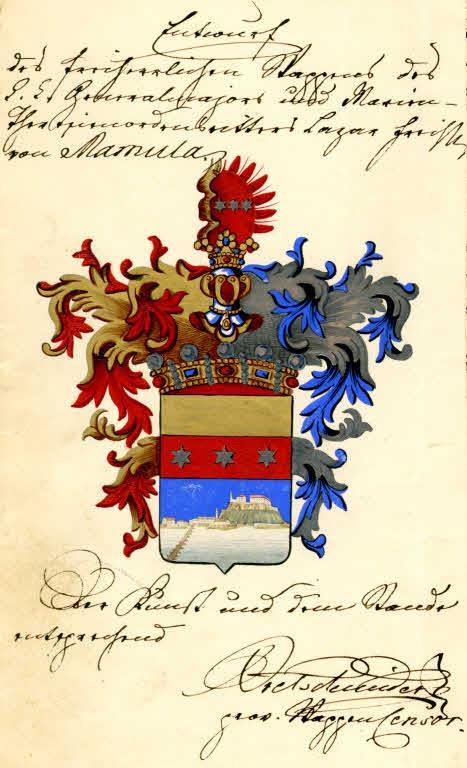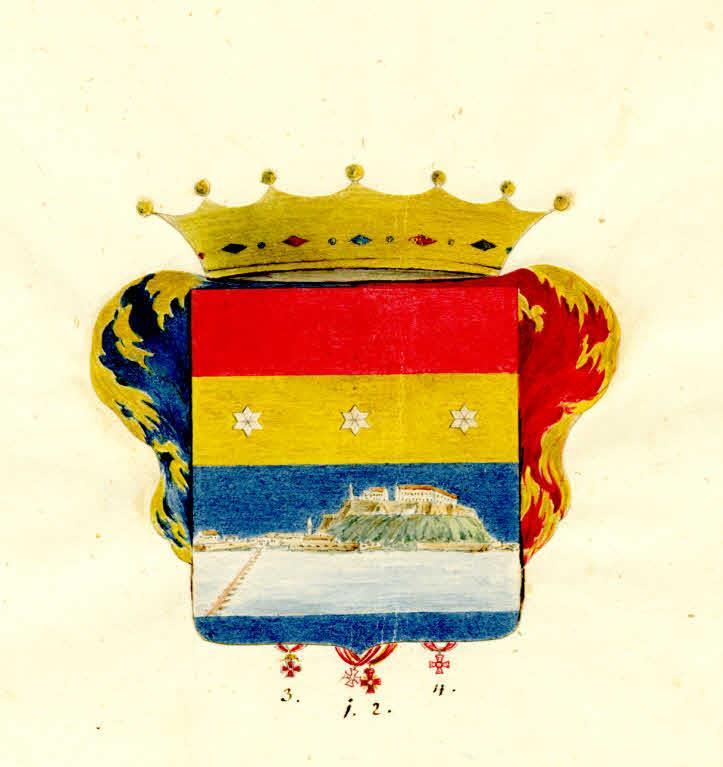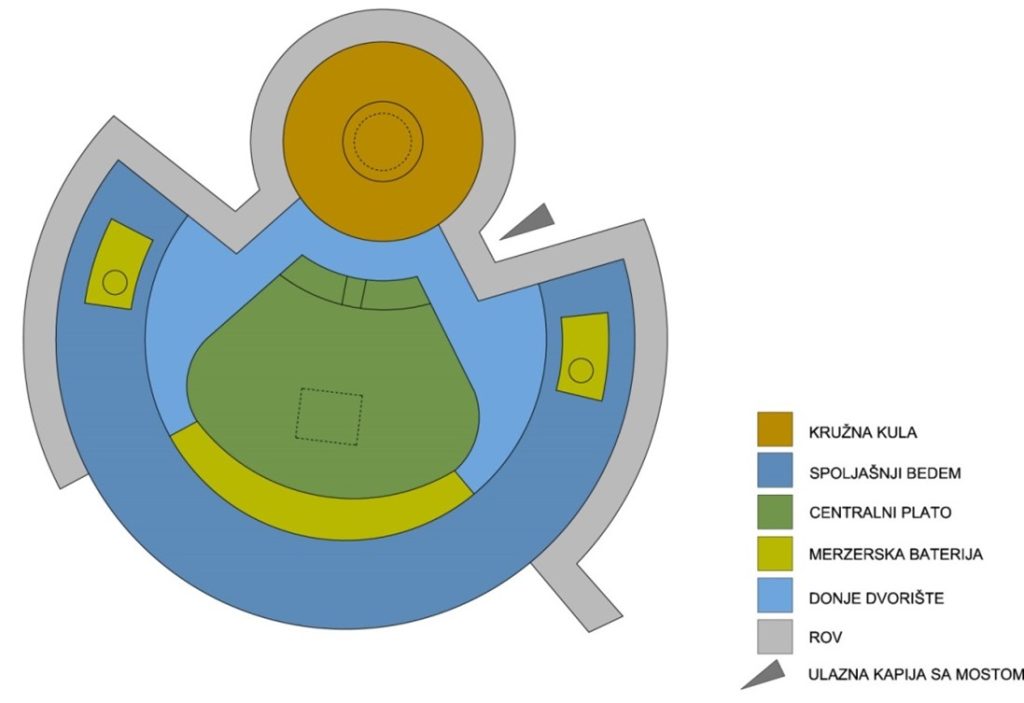The island of Lastavica is situated at the entrance to the Boka Bay, between Capes Arza and Oštro. Its historical name, Scoglio Rondoni, originates from the Venetian period and is derived from the Italian word il rondone, referring to a type of swift bird similar to a swallow (Apus apus). The island occupies an exceptional position, offering expansive views of both the open sea and the interior of the bay. However, its natural features, characterised by sharp and steep cliffs, make it difficult to access, even during calm summer weather. Vessels can approach only from the northern side, which is somewhat more sheltered and still features a small, well-preserved mulo (pier) from the Austro-Hungarian period.
Fort Mamula is one of three forts forming the first line of defence for the fortress of Boka Bay. In accordance with Regulation No. 5994 issued by the General Directorate for Engineering in Vienna in 1850, the Directorate for Engineering Works in Kotor (die K.u.K. Genie Direction) began preparing the initial plans for a permanent fortification on the island of Rondoni (Lastavica) at the entrance to the Boka Bay. Between 1850 and 1854, this impressive military fortification was constructed under the supervision of Admiral Lazar Mamula.
Lazar Mamula (1795-1878) was born the son of a captain in the Imperial-Royal Military Frontier (German: Militärgrenze). He received his education at a gymnasium and at the Imperial-Royal Engineering Academy in Vienna. He began his military career in 1815 in the engineering corps, quickly advancing through the ranks. He played a key role in the construction of several military fortifications, including Franzensfeste, Lissa, and Komorn.
In 1841, he was promoted to the rank of major and appointed Director of Engineering for Tyrol and Vorarlberg in Innsbruck.
.

Author: Joseph Kriehuber, 1853
In 1848, at the request of Archduke Johann, the German administrator of the empire, who was well aware of Mamula's experience and capabilities, he was summoned to the war department in Frankfurt am Main and offered the rank of colonel. However, he declined this prestigious position and instead made himself available to Ban Josip Jelačić in Croatia.
In 1849, he was appointed as a colonel to the forces stationed near Petrovaradin under the command of Count Laval Nugent (1777–1862). Acting on Nugent's orders, he was responsible for overseeing the fortress and reinforcing its positions. On 29 March, he successfully repelled an attack by the enemy garrison, securing the imperial army's positions and preventing further enemy advances into Srijem and Slavonia. For this remarkable feat, he was honoured with the Knight's Cross of the Military Order of Maria Theresa and the Military Cross of Merit..
In 1852, he was appointed Military and Civil Governor, as well as Commanding General of Dalmatia. In this role, he engaged in significant humanitarian work, earning the nickname "Father Mamula" among the local population.
In 1865, he retired due to eye problems (cataracts), holding the rank of Field Marshal.
Lazar Mamula was the recipient of numerous prestigious honours, including: Real Privy Councillor, lifetime member of the House of Lords of the Imperial Council, bearer of the Command of the 25th Infantry Regiment, the Grand Cross of the Austrian Order of Leopold with the War Decoration, Knight of the Austrian Order of the Iron Crown First Class, Knight of the Military Order of Maria Theresa, and recipient of the Military Cross of Merit with the War Decoration.
.
.
.



Mamula belongs to a type of fortification known as a fort. These are smaller, permanent defensive structures forming part of a belt fortress, designed to independently organise their defence. Such forts were equipped with manpower, weaponry, ammunition, and supplies, enabling autonomous operation and combat. Mamula was constructed as a circular, multi-storey tower with flanking guns in casemates and two casemate batteries (east and west), each armed with six guns. However, with advancements in weaponry—particularly the rifled cannon (1858–1863) and explosive shells—the fortress's armament became obsolete. Furthermore, its high, insufficiently thick walls rendered it ineffective for defence. As a result, only a decade after its construction, the fortress was almost unusable for its original purpose. To modernise the Mamula fortress and adapt it to newer weaponry, significant upgrades were made in 1875. These included the addition of the Merzer battery in the southern section of the fortification, between the central courtyard and the outer rampart. The construction of the Merzer battery marked the first use of concrete in fortifications within Boka Bay. While the concrete was unreinforced, it was employed to cover flat roofs, walkways, and cannon platforms. The Merzer battery on Mamula comprised positions for four 210 mm cannons, a room for ammunition storage, and a central armoured observation post. This modernisation extended the range of the fortress's cannons to 10.5 km, restoring its operational capacity. Initially, the fortress was equipped with around 40 cannons of various calibres. By the time of the First World War (1914), its armament included four M-1873 210 mm Merzers, eight M-95 80 mm cannons, and ten M-75/96 80 mm cannons, as well as a searchlight for enhanced operational capability.
During the First World War, the French naval fleet entered Adriatic waters nine times, albeit briefly. On three occasions, it attacked the fortifications at the entrance to the Boka Bay. The first attack occurred on 1 September 1914 at 7:30 a.m. The fleet, under the command of Admiral Auguste Boué de Lapeyrère, opened fire on Mamula from a distance of 13,000 metres. Each 305 mm cannon fired 10 shells during the 15-minute bombardment. Despite the attack, Mamula sustained no significant damage. The fort’s guns did not return fire, as the French ships were beyond their range. This initial assault was the only planned attack on the forts guarding the entrance to the Boka Bay; the subsequent two were unplanned. The second attack took place on 19 September 1914. It was carried out by the reinforced Second Light Division of Ships, commanded by Rear Admiral Senés. Due to heavy fog, the French fleet inadvertently approached the coastline to within approximately 5,000 metres, where they were spotted by the fortification's crew and fired upon. Cannons from Luštica, with a 150 mm calibre and a range of 10.5 km, and 210 mm mortars from Cape Oštro targeted the French ships. However, Mamula did not engage during this skirmish
When the French ships returned fire during the second attack, Fort Mamula was struck from a distance of 5,000 metres. One 305 mm shell dislodged the earthen layer on the breastworks, penetrated 12 metres of wall and ground, and exploded in the soldiers' galley and the circular tower itself. Another shell damaged part of the rampart. All three forts—Mamula, Arza, and Oštro—were attacked during this engagement, resulting in the death of one sailor and injuries to two others.
The third attack took place on 17 October 1914, but Mamula was not targeted. This assault marked the last time warships fired on the fortresses at the entrance to the Boka Bay. On 14 January 1915, the French submarine Monge arrived at the entrance to Boka Bay and remained there for two days.
Latter, the fortress on Lastavica island had been renamed to Mamula. Witness to that was a telegram from 31 August 1865:

Translation of the telegram is as follows:
The first assistent of the Army to His Excellence Mister F.M.L. barron Mamula, in Zadar. Vienna 31 August 1865.
His Majesty Emperor has kindly givven me the task to wish you good luck in the most deserved retirement and at the same time the most kindly ordered that, as permanent remider of Your Excellency in the Kingdom of Dalmatia, the name of the fortress "Scoglie Rondoni" near Kotor from now on, will be named "Fortress Mamula". From K.U.K. main telegram station Zadar. Telegram no. 1949 sent from Vienna Court on 31 August 1865 at 12 hours and 10 minutes, arrived to Zadar on 31 August at 1 hour 35 minutes.
Iz K.U.K. telegram glavna stanica Zadar. Telegram br. 1949 poslat iz Bečkog dvora 31. avgusta 1865. u 12 časova u 10 minuta, stigao u Zadar 31. avgusta u 1 čas i 35 minuta.
Mamula belongs to a type of fortification known as a fort. These are smaller, permanent defensive structures forming part of a belt fortress, designed to independently organise their defence. Such forts were equipped with manpower, weaponry, ammunition, and supplies, enabling autonomous operation and combat. Mamula was constructed as a circular, multi-storey tower with flanking guns in casemates and two casemate batteries (east and west), each armed with six guns. However, with advancements in weaponry—particularly the rifled cannon (1858–1863) and explosive shells—the fortress's armament became obsolete. Furthermore, its high, insufficiently thick walls rendered it ineffective for defence. As a result, only a decade after its construction, the fortress was almost unusable for its original purpose. To modernise the Mamula fortress and adapt it to newer weaponry, significant upgrades were made in 1875. These included the addition of the Merzer battery in the southern section of the fortification, between the central courtyard and the outer rampart. The construction of the Merzer battery marked the first use of concrete in fortifications within Boka Bay. While the concrete was unreinforced, it was employed to cover flat roofs, walkways, and cannon platforms. The Merzer battery on Mamula comprised positions for four 210 mm cannons, a room for ammunition storage, and a central armoured observation post. This modernisation extended the range of the fortress's cannons to 10.5 km, restoring its operational capacity. Initially, the fortress was equipped with around 40 cannons of various calibres. By the time of the First World War (1914), its armament included four M-1873 210 mm Merzers, eight M-95 80 mm cannons, and ten M-75/96 80 mm cannons, as well as a searchlight for enhanced operational capability.
During the First World War, the French naval fleet entered Adriatic waters nine times, albeit briefly. On three occasions, it attacked the fortifications at the entrance to the Boka Bay. The first attack occurred on 1 September 1914 at 7:30 a.m. The fleet, under the command of Admiral Auguste Boué de Lapeyrère, opened fire on Mamula from a distance of 13,000 metres. Each 305 mm cannon fired 10 shells during the 15-minute bombardment. Despite the attack, Mamula sustained no significant damage. The fort’s guns did not return fire, as the French ships were beyond their range. This initial assault was the only planned attack on the forts guarding the entrance to the Boka Bay; the subsequent two were unplanned. The second attack took place on 19 September 1914. It was carried out by the reinforced Second Light Division of Ships, commanded by Rear Admiral Senés. Due to heavy fog, the French fleet inadvertently approached the coastline to within approximately 5,000 metres, where they were spotted by the fortification's crew and fired upon. Cannons from Luštica, with a 150 mm calibre and a range of 10.5 km, and 210 mm mortars from Cape Oštro targeted the French ships. However, Mamula did not engage during this skirmish
When the French ships returned fire during the second attack, Fort Mamula was struck from a distance of 5,000 metres. One 305 mm shell dislodged the earthen layer on the breastworks, penetrated 12 metres of wall and ground, and exploded in the soldiers' galley and the circular tower itself. Another shell damaged part of the rampart. All three forts—Mamula, Arza, and Oštro—were attacked during this engagement, resulting in the death of one sailor and injuries to two others.
The third attack took place on 17 October 1914, but Mamula was not targeted. This assault marked the last time warships fired on the fortresses at the entrance to the Boka Bay. On 14 January 1915, the French submarine Monge arrived at the entrance to Boka Bay and remained there for two days.

According to the report of its commander, the French submarine Monge approached to within 800 metres of the Oštro-Mamula line, where it came under fire from both Mamula and Punta Oštro. On 29 December 1915, while patrolling near the entrance to Boka Bay under the command of Roland Morillot, Monge was spotted, attacked, and sunk by the Austro-Hungarian destroyer Heligoland. From 1854 until 1918, Fort Mamula functioned exclusively as a military facility, remaining armed and operational throughout this period.

Structurally, Fort Mamula consisted of the following buildings: 1. round tower with casamates on 2 levels, underground water tank, and oservation platform on the top; 2. arched (~3/4 of circle) outer rampart with Eastern and Western casamate battery on the lower level; the upper level contained 3 watch towers - central, Easter, and Western, infantry and machine gun posts; 3. central courtyard - spatious elevated area for training and excercise of soldiers; under it is the main water tank of volume of cca 420 qubic meters; 4. the lower courtyard surrounding the upper plato is used as communication area between rooms of the outer rampart and round tower; 5. Mörser battery (210 mm) with central armored watch tower; 6. stone built and paved moat surrounding the entire fortification.
The fortress is encircled by a deep, walled, and paved moat, as well as steep rocky terrain. The moat surrounds the circular tower and nearly the entire outer rampart. Observation posts were positioned on the rocks around the fort, providing additional vantage points. The rest of the island, beyond the fortifications, was interconnected by roads and paths leading to these observation posts, many of which have been preserved to this day.
Boat access is possible only on the northern side of this rocky island, where the coastline is somewhat milder and more accessible. For the purposes of fortification, a small pier was constructed here, from which a narrow, paved path leads to the entrance of the fortress. The path follows the natural contours of the terrain, with uneven sections managed by gentle slopes and a stone staircase. Adjacent to the pier is a small stone building, formerly used by a watchman to monitor departures and arrivals. The path culminates at a drawbridge in front of the fortress’s entrance gate.
The circular tower is the central building of the complex. The rooms on the ground floor and first floor are arranged around an open, paved inner courtyard with a well, beneath which lies a circular water tank with a capacity of approximately 225 cubic metres. The interior of the tower is radially divided into 14 rooms: 12 casemates designed for housing and operating cannons, an entrance corridor with a freight elevator, and a space containing a spiral staircase that leads to the roof terrace.
The top terrace protected with thick wall was used as an area for control and action. Delivery of munition to the top terrace was done via cargo elevator. 2.


